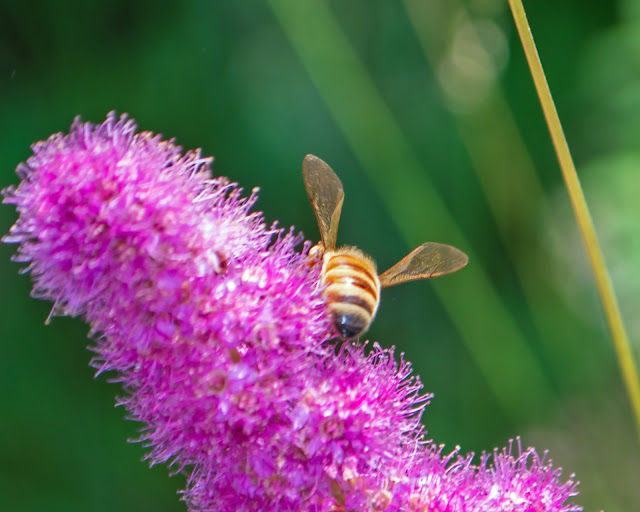I haven't seen many bees this summer; one or two on my roses, one checking out the nasturtiums, and that's about it. I walked down a short path by the beaver pond, past daisies, fireweed, and St. John's wort, in profuse bloom. No bees. And then there's a patch of hardhack. Swarming with bees.
 |
| I was too slow to catch the bee on this one. |
 |
| Pink reflections in her eye. Only the females have those pollen baskets on their legs. |
 |
| So intent on her harvesting. |
 |
| A honeybee with wings like deer's ears. |
 |
| Blurry wings and dangling legs. |
There were many bees on a friend's lavender, too. But not on all the other flowers in her garden. Curious. Why are they limiting themselves to a few specific plants this year? I've never seen this behaviour before.
And would this have anything to do with only 2 pears on a pear tree that usually bears bags full?
¿Y será por esto que el peral este año solamente lleva dos peras?
~~~~~~~~~~~~~~~~~~~~~~~~
Este verano he visto muy pocas abejas. Una o dos visitaron mis rosas; había una viendo mis capuchinas, nada más. El otro dia visité la laguna de los castores, entrando por una vereda donde florecían abundantemente las margaritas, las adelfillas (hierba de fuego), y hierba de San Juan; no vi ni una sola abeja en todas esas flores. Y luego siguen los arbustos de Spiraea douglasii. Y aquí era un hervidero de abejas, de varias especies, apurándose de una rama de flores a la siguente.
Fotos: Spiraea douglasii, con abejas. Menos la primera; se me escapó la de esta rama.
Hoy había muchas abejas en la lavanda de una amiga, también. Pero las otras flores de su jardín, ni una. Esto me parece muy curioso. ¿Porqué están escogiendo solo esas plantas ahora? Nunca antes he visto esto.




